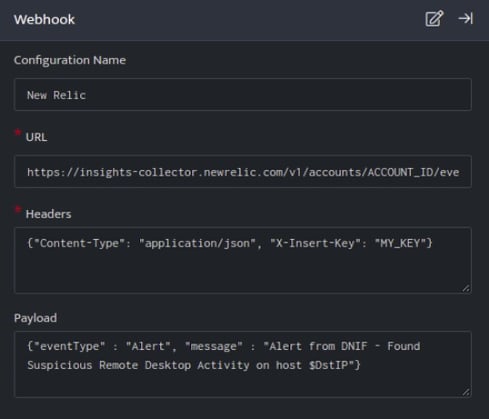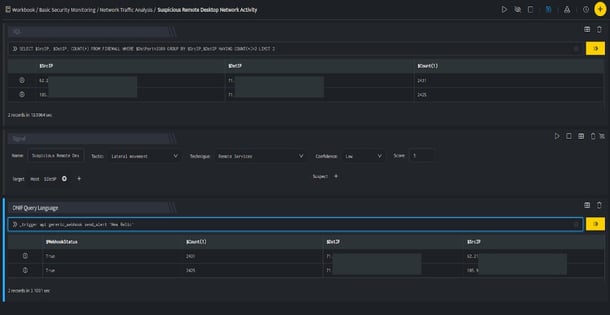- KNOWLEDGE BASE
- AUTOMATION
- SUPPORTED AUTOMATION
-
START YOUR TRIAL
-
DEVICE INTEGRATION
-
CONNECTORS
-
DATA INGESTION
-
HUNTING WITH WORKBOOKS
-
DNIF Query Language (DQL Language)
-
SECURITY MONITORING
-
OPERATIONS
-
MANAGE DASHBOARDS
-
MANAGE REPORTS
-
USER MANAGEMENT & ACCESS CONTROL
-
BILLING
-
MANAGING YOUR COMPONENTS
-
GETTING STARTED
-
INSTALLATION
-
SOLUTION DESIGN
-
AUTOMATION
-
TROUBLESHOOTING AND DEBUGGING
-
LICENSE MANAGEMENT
-
RELEASE NOTES
-
API
-
POLICIES
-
SECURITY BULLETINS
-
BEST PRACTICES
-
DNIF AI
-
DNIF LEGAL AND SECURITY COMPLIANCE
New Relic
New Relic webhook connections allows you to send alert results to New Relic as a custom event. You can learn more about New Relic.
Configuration
- In the Configuration Box, enter the Configuration Name to uniquely identify this configuration.
- Identify the content of headers and payload that you need to provide in the Configuration Box.
Below is an example on how you can leverage this integration to create an event on New Relic.
Payload
{
"eventType":"Alert",
"message":"Alert from DNIF - Found Suspicious Remote Desktop Activity on host $DstIP"
}

New Relic, creates an event on the New Relic account based on the values given in the payload.

In the above figure, a workbook named Suspicious Remote Desktop Network Activity is executed which contains the following blocks:
- SQL Block: Displays two suspicious Destination IPs on execution of the workbook
- Signal Block: This will raise a signal on detecting the suspicious IPs.
- DQL block with _trigger query: Using Webhook integration for New Relic, an event will be created on New Relic based on the values given in the payload.
